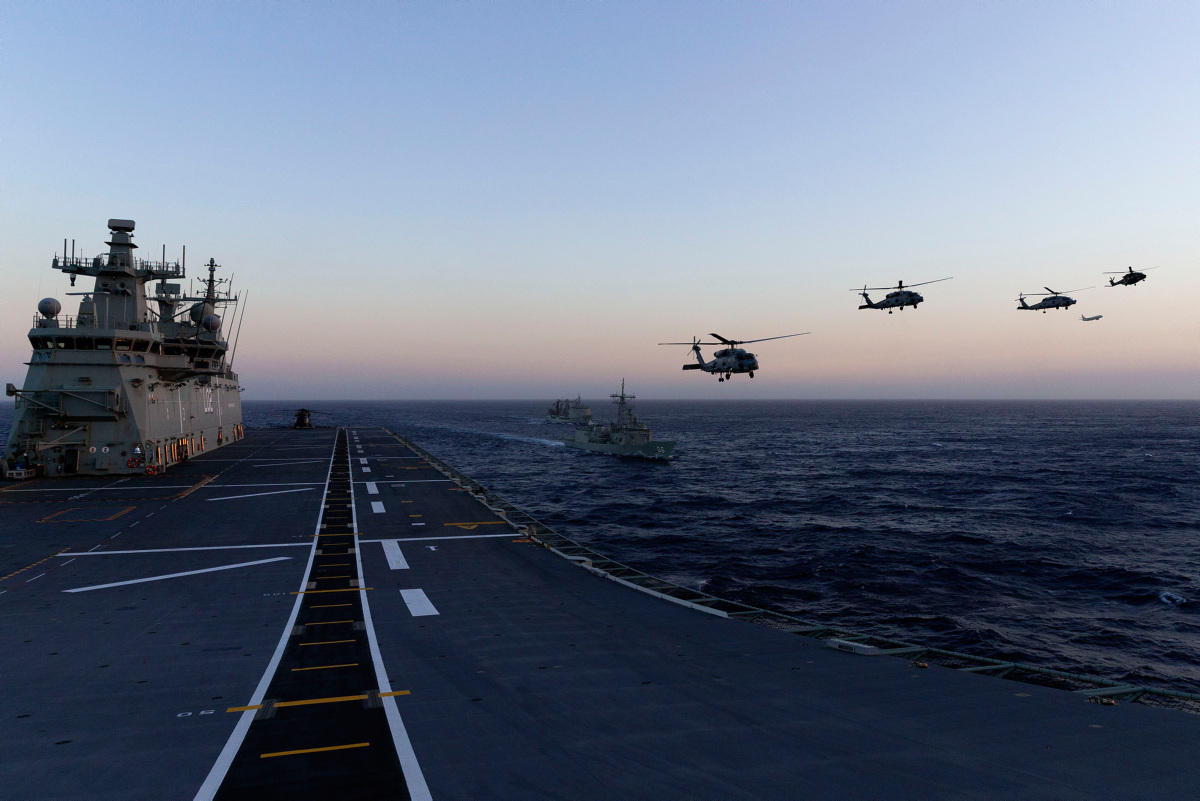
The recent revisiting on The Strategist of the arguments around taking the F-35 to sea cast my mind back to the bitter carrier debate of the 1970s and early 1980s. The current discussion certainly doesn’t appear to bring with it the same level of interservice acrimony, political manoeuvring or sheer dirty-trickery that took place back then. Nevertheless, the isolated and zero-sum nature of some of the arguments and counterarguments seems familiar, and it occurs to me that—despite the great strides we’ve made in jointery—the one-dimensional character of our strategic capability planning really hasn’t changed all that much.
The back and forth over combat ranges, weapons loads, sortie rates and the many other comparisons between the different F-35 variants really misses the point. Unless we know what we’ll need our military to do, and precisely what kind of environment it will need to do it in, a comparison of these indicators is pretty academic.
If all we’ll ever want the LHDs to do are flag-waving exercises or moving an amphibious force around within about 400 miles of an established airbase, or in a permissive environment with established sea control, then modifying the LHDs and procuring some F-35B short take-off and vertical landing variants in place of some F-35As probably isn’t worth it. But I don’t know anyone with that level of strategic certainty.
As we enter this new reality of strategic competition, move within the so-called warning time we’ve relied on for so long, and face a strategic environment that is less and less certain, surely flexibility and integration should be the hallmarks of our military capability, especially given our limited force size.
Rather than maintaining a pair of amphibious ships that are good for a very limited number of wartime tasks, we should look to maximise their potential and give future decision-makers a range of options for a variety of circumstances—not to mention helping to complicate the operational environment for any adversary.
Using the ships for a different purpose would of course affect their ability to simultaneously achieve their core amphibious role, but that isn’t a reason to deny ourselves the option. A flexible platform capable of configuration for local air defence, trade protection, strike, close air support, extended ISR (intelligence, surveillance and reconnaissance), massed airborne anti-submarine warfare, and/or amphibious operations is surely better than the one-trick pony we have.
The ability to mix and balance the operational potential of the platforms—limited though they may be—to meet the needs of the day, in a decreasingly predictable environment, would give us an exponentially stronger and more flexible capability over the long term. But despite having (or being about to have) almost all the component parts, or variants thereof, this is not the capability we’ve ended up with. Not even close.
So how did we get here? Despite the procurement of two large and complex LHDs, joint strike fighters and a whole host of other potential force multipliers over the years, we somehow managed to avoid bringing them together in anything resembling a deliberately coordinated capability. It’s tempting to imagine a reality in which our armed reconnaissance helicopters were marinised for LHD operations, our multirole helicopters equipped with automatic folding rotor blades, our tanks capable of being embarked without sinking their landing craft, our new fighters capable of being launched and recovered, and a flight deck with the necessary heat resistance. But, alas, we have none of those things.
Unhappily, although the concept of jointery has progressed significantly since the last carrier debate, our strategic approach to capability remains very much one-dimensional and platform-centric. A key factor here is that our strategic guidance remains broad enough to allow the different services to take their own individual perspective on capability, especially in view of the inherently differing nature of the three strategic defence objectives. As a former chief of navy once said of such guidance, ‘It’s main use was to give each of the services a peg upon which to hang their requests of manpower and equipment, and the language of the document was such that a peg could be found for almost any request.’
So while the professional acrimony that existed between Pritchett, Synnot, Willis, Dunstan, McNamara and others during the debates of the early 1980s is thankfully behind us, the differing strategic beliefs and desires of the services are not. That disjointedness is reflected most starkly in the RAN’s increasing focus on power projection and sea control, while the RAAF remains anchored in its traditional defence of Australia and sea denial doctrine.
And while these differing approaches can all be aligned to the same guidance, the net result is a set of platforms and systems which—while seemingly justified in isolation—don’t provide us with a mutually reinforcing capability beyond the sum of their parts. That’s not to say that they’re not interoperable in the strict sense of the word: many different platforms can communicate and share sensor data, for instance; they’re just not designed to achieve the same strategic objectives.
In the passive regional strategic environment of recent years, we’ve had the luxury of being able to fall back on warning time, the ‘core force’, ‘for but not with’ and other resource-saving measures, and we’ve been able to accommodate this lack of integrated capability. The flip side of that approach, obviously, is that a changed environment requires a more integrated, larger and more potent maritime force.
We should start by examining the force we have, and making the changes needed to transform an assortment of existing but largely disparate systems into the potent power-projection capabilities they should be. And at the capability-planning level, it’s time to step up, set a clear direction and pull some pegs out of the wall.

